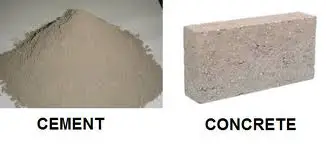It is quite usual for many to use the term cement and concrete interchangeably. In fact the two are not the same. Concrete is a mixture of a few items, of which cement is an important constituent. The other usual constituents of concrete are aggregates and any type of cement plus water. Cement acts as a binding agent that keeps together all the elements of concrete. Aggregates are usually inert coarse materials like crushed stone, gravel and sand. The nature of aggregate selected varies with the application of the concrete. So, concrete and cement are not same. There are differences between cement and concrete which we will discuss in this article.

Cement
Cement is a binding material that is made by grinding calcined limestone and clay into a very fine powder. It contains mostly calcium and silicon. Different combinations of the calcium silicate, calcium aluminate and calcium aluminoferrite determines the drying time and the color of the cement. Cement is the binding agent used in concrete. Cement is also used when making mortar.

Concrete
Concrete is a heterogeneous mixture of cement, sand, crushed stone (or brick chips) and water. Aggregates like sand and stone are inert while cement and water undergo chemical changes and the mass hardens like artificial stone. Approximately, 7.5 gallons of water is needed per bag of cement. When steel is added for strength it is called Reinforced Concrete. There is light and heavy weight concrete used for specific purposes. Building codes do not specify brick chips to be used in concrete instead of stone chips. However, it is used in our country as a substitute of stone, as such for maintaining quality, picked bricks should be used.
Read: Advantages and disadvantages of using concrete
Concrete is cement mixed with rocks and sand. The rocks and sand form most of the mass and then the cement is the binding agent that holds the rocks in place. It is used in building construction as it is a harder, more durable substance. Concrete can be bought in a ready mix form at most hardware stores. For large construction projects, concrete will be trucked in and used as a continuous pour.
Differences Between Cement and Concrete
There are some misconceptions among so many that cement and concrete are same. There are some major differences between cement and concrete. The differences are shown by a cement vs concrete table below. You can also know about the differences between concrete and mortar here.
Cement |
Concrete |
|
|
|
|
|
|
|
|
|
|
|
|
|
|
|
|
|
|


it is very nice information regarding diff. between cement and concrete. i donot getting anywhere. thanks.
Thanks for your appreciation.
I was finding this info but i didnt get anywhere… thanks a lot for sharing this infooo